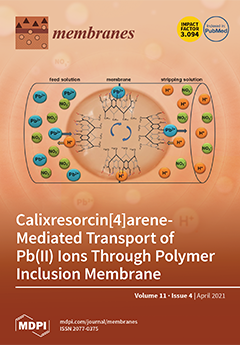A series of new poly(ethylene oxide) (PEO)-based copolyimides varying in hard segment structure are reported in this work as CO
2 selective separation membranes. Their structural diversity was achieved by using different aromatic dianhydrides (4,4′-oxydiphthalic anhydride (ODPA), 4,4’-(hexafluoroisopropylidene)diphthalic anhydride (6FDA)) and diamines (4,4′-oxydianiline
[...] Read more.
A series of new poly(ethylene oxide) (PEO)-based copolyimides varying in hard segment structure are reported in this work as CO
2 selective separation membranes. Their structural diversity was achieved by using different aromatic dianhydrides (4,4′-oxydiphthalic anhydride (ODPA), 4,4’-(hexafluoroisopropylidene)diphthalic anhydride (6FDA)) and diamines (4,4′-oxydianiline (ODA), 4,4′-(4,4′-isopropylidene-diphenyl-1,1′- diyldioxy)dianiline (IPrDA), 2,3,5,6-tetramethyl-1,4-phenylenediamine (4MPD)), while keeping the content of PEO (2000 g/mol) constant (around 50%). To get a better insight into the effects of hard segment structure on gas transport properties, a series of aromatic polyimides with the same chemistry was also studied. Both series of polymers were characterized by
1HNMR, FTIR, WAXD, DSC, TGA, and AFM. Permeabilities for pure He, O
2, N
2, and CO
2 were determined at 6 bar and at 30 °C, and for CO
2 for pressures ranging from 1 to 10 bar. The results show that OPDA-ODA-PEO is the most permeable copolyimide, with CO
2 permeability of 52 Barrer and CO
2/N
2 selectivity of 63, in contrast to its fully aromatic analogue, which was the least permeable among polyimides. 6FDA-4MPD-PEO ranks second, with a two times lower CO
2 permeability and slightly lower selectivity, although 6FDA-4MPD was over 900 times more permeable than OPDA-ODA. As an explanation, partial filling of hard domain free voids by PEO segments and imperfect phase separation were proposed.
Full article






